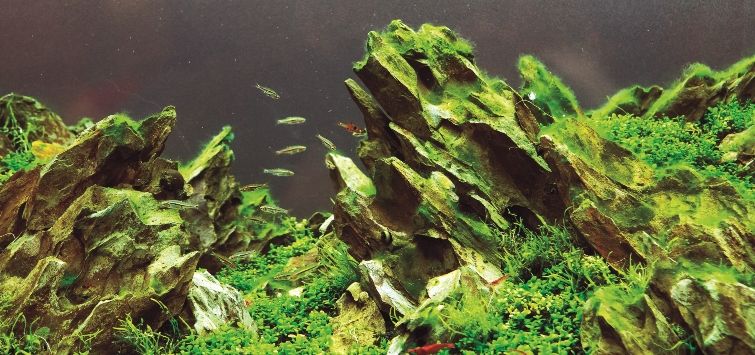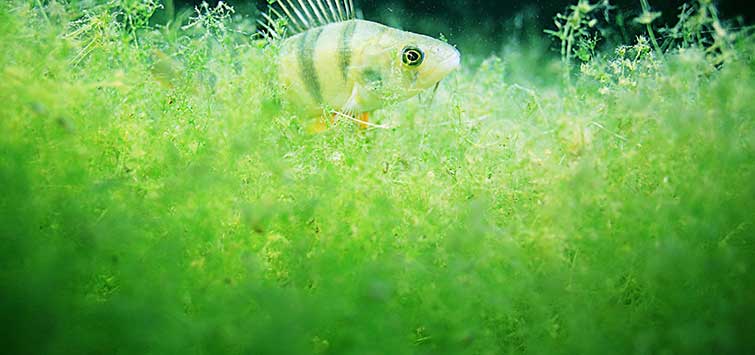How to Get Rid of Algae in a Planted Fish Tank
Author:Lea Maddocks
Algae are usually the first things to grow in a new underwater environment as it establishes, and it is natural for them to be present in virtually all aquatic environments. But in a planted aquarium, especially one using high lighting and fertilizers, algae can grow rampantly when imbalances in the water chemistry or environment make conditions inconducive to plant growth. Algae will generally take advantage of rapid changes in water quality, excess nutrients, and excess lighting when the plants in the tank fail to adapt fast enough.By understanding the cause of algae growth and figuring out how to get rid of algae in your fish tank, it can be limited to nearly or completely invisible levels. There are ways to run a planted aquarium that will help keep it free of visible algae overall, as well as methods to specifically identify various types of algae and get them under control. With a keen eye, as well as an understanding of how algae and plants respond to their environment, you’ll be able to keep your aquascape healthy and beautiful.
Combatting Algae Growth
First, let’s look at general algae-causing conditions. Most people will appreciate that neglect in a variety of areas can cause algae outbreaks. This generally presents as a buildup of waste in terms of high nitrates and phosphates, and a buildup of organics such as livestock waste, dead animals, and decaying plant matter. These outbreaks can be especially bad when combined with excessive light and/or if the lighting has a poor spectrum.
Many people’s initial reaction to finding an algae outbreak will be to do very large water changes and a deep clean of the gravel, and either leave lights off or block light out entirely for several days. In my experience, while this approach can help get some algae on aquarium plants under control, it is rarely helpful long term. It can, in fact, cause algae to increase. Let’s break down why this happens by looking at how algae grow.
Algae are opportunistic and will thrive in changeable conditions, easily taking over when plants are failing. Doing a large water change can shock plants and rapidly change water chemistry, not only in terms of waste and nutrient levels but also massive swings in pH and hardness if the tank has been neglected for some time. This is because tanks with high waste buildup can also suffer from “old tank syndrome,” where the hardness is low after buffers and salts have been consumed and the pH slowly drops from the presence of waste.
A rapid change such as this can shock plants, but worse, it can shock livestock to the point of ill health or death. Deep gravel cleaning can also throw waste into the water column as it is disturbed by the cleaning process, creating ammonia spikes and upsetting the balance of the tank’s bacterial populations. It may also disturb roots of established plants.
Blocking out light is also a problem, as many algae are quite content to survive on limited lighting or will come back quickly when the blackout period is over and the light returns. Most plants will also survive a blackout and recover, but they may take longer to do so, giving algae the upper hand in recovering.
Additionally, blacking out the tank can cause some very fast-growing plants to deteriorate quickly, further polluting the aquarium. Like many things in life, finding a sensible middle ground is generally the way to go. When an algae outbreak stems from high wastes, neglect, or improper lighting, this should be corrected in a way that does not rapidly disrupt the conditions of the aquarium and favors strong plant growth going forward.
Correcting a high-waste or neglected tank is best done by first testing the water and determining the pH, hardness (GH and KH), and nitrate levels. From here, you can determine how to bring the tank back to health. If levels have shifted from targets significantly, a series of small and more frequent water changes with added buffers and salts can bring it back to the correct level. Monitor your aquarium chemistry during this time to be sure that things are progressing smoothly.
During these smaller and more frequent water changes, a light gravel vacuuming of different non-planted sections would also be beneficial. Run a wooden or clean metal skewer through the gravel to aerate sections and remove anaerobic pockets, which can also be dangerous over time and deter plant roots from spreading. Direct the siphon tube carefully around hardscape where levels of mulm may have accumulated deeply and, if possible, lift and carefully vacuum underneath rocks, driftwood, and other décor to remove significant fuel for algae growth.
Removing any algae you can manually wipe, pick, or otherwise detach from the substrate and hardscape, and pruning it away from affected plants is also recommended to reduce the load. Cleaning the filter media gently in old aquarium water at each change is also needed to remove accumulated debris and further wastes that are trapped after being stirred up at each cleaning. Working in a methodical way like this will gradually and safely remove wastes both visible and dissolved over time and restore conditions more favorable to plant growth.
Helping Plants Outcompete Algae
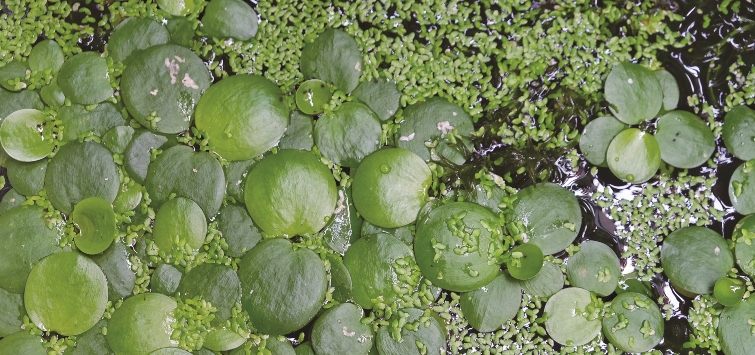
During this time, it is also recommended to plant out any bare patches with fast-growing plants, or adding fast-growing floating plants, even temporarily, to help outcompete algae. These plants can be removed when things are under control again as needed. Floating plants are especially good for this, and they can also help provide some shade if the plants beneath don’t require bright lighting.
Adjusting your lighting is also important during this time; it should be cut back if lighting periods are beyond 10 hours a day. And if it has been a long time since replacing bulbs, then this is recommended, too. This is because the spectrum of old bulbs can shift over time, and sometimes this can leave algae at an advantage over healthy plants. Look for bulbs with a high Kelvin color rating or bulbs specifically designed for planted tanks.
Ensure that your lighting period is also consistent by using a timer if you are not punctual in turning your lights on and off during the day, as plants will favor a predictable photoperiod over an irregular one. You can also use a timer to break up light periods into two or more regular blocks as a useful way of enjoying your tanks morning and night without leaving the lights on all day, and it can help with keeping more consistent CO2 levels.
Briefly, this works by allowing dissolved CO2 levels, which are depleted by plants as they photosynthesize during a lights-on period, to replenish during a lights-off period (CO2 in this case being provided by livestock and aerobic bacteria, as well as normal plant respiration). Another good way of improving available CO2 to your plants while also deterring algae is to dose the aquarium daily with an aquarium solution containing glutaraldehyde, which is known to provide some bioavailable carbon as well as act as a mild algicide.
Check, too, that your plants are acquiring enough macro- and micronutrients to thrive. Most aquariums have enough nitrate and phosphate (and you can test for this), but other nutrients, such as potassium or iron, are commonly in deficit, so look for telltale signs of deficiency and try a supplement in small doses to see if this helps. While rarer, deficiencies in micronutrients can also occur, and a liquid supplement containing a good mix of micronutrients dosed occasionally can be very helpful to get things back on track. It may take a few weeks to see the difference, but as soon as plants are thriving, algae usually starts to reduce.
If algae issues are especially entrenched or out of control, an over-the-counter algicide can be useful. Note that this is recommended only when you are also treating the cause of the algae issue; otherwise, the algae will simply return quickly or remain very hard to beat. Be aware that not all algicides are plant-safe, and some may be unsafe for certain aquarium residents, for example shrimp, so check the product instructions for any one you use.
Biological Controls
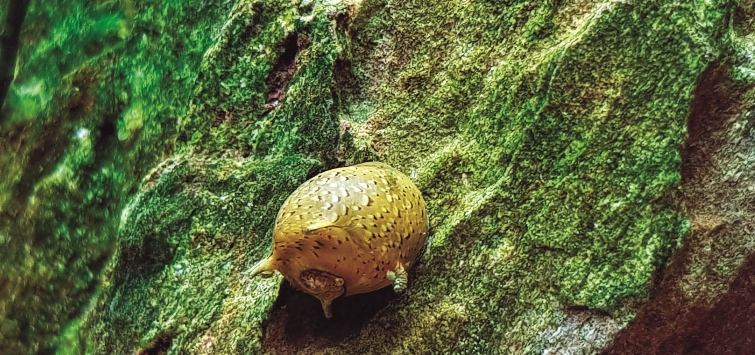
Speaking of shrimp, many aquarists attempt to rely on animals to control algae—adding an “algae eater” of some sort. While these animals definitely help control algae, and can help minimize a minor outbreak, they should not be the first line of defense against algae on aquarium plants.
I’ve suggested a few algae eaters in what follows to try to help out as a further biological control, but don’t expect them to clean the tank—that’s your job. Also, be sure to provide supplemental feedings to any animals added to the tank as part of a “clean-up crew,” as their algae-grazing alone is not enough to sustain most species.
Identifying and Fighting Different Algae Types
Now for a closer look at certain types of commonly occurring algae and ways to treat them directly. Note that this should be in addition to working on improving general aquarium conditions, as outlined above, to treat the cause at its source and prevent further outbreaks of any kind. This is not an exhaustive list of freshwater algae types (that would take a book rather than an article) but a shortlist of the most commonly occurring algae issues seen by novice and intermediate planted tank keepers.
Keep in mind also that numerous factors can be responsible for an algae outbreak of various kinds, so while some algae are more notorious for popping up when a certain nutrient or factor in the tank is out of balance, it may not be the whole story. Always consider your aquarium as a whole and examine each aspect and how it interplays with others. This is always the key to having a thriving ecosystem: keeping healthy plants and minimizing algae.
Green Spot Algae
Green spot algae will usually present as small green spots, typically seen on the aquarium glass. It generally stems from an excess of phosphates and other organics. The best treatment is to manually remove it with a glass-safe aquarium sponge—or, taking care to avoid scratching, a clean razor blade—while treating the cause of the nutrient imbalance. Strong lighting in one area can cause it to be especially bad.
Several types of snails can be used in the aquarium to control green spot algae. The best of these are the nerite snails, especially the spikey sun snail, Clithon sp., though other nerites have some effect. Small outbreaks can also be managed by oto cats (Otocinclus spp.) and twig catfish (Farlowella spp.).
Black Brush Algae
Black brush algae (BBA) appears as short tufts of dense, soft, black hair. This can grow on glass, gravel, hardscape, leaves, ornaments, or anywhere else. BBA is usually the result of too much lighting accompanied by high nitrate and phosphate and high organic mulm buildup (especially in very dirty filters, in my experience). It is a common sight in neglected aquariums.
This type of algae can be very difficult to remove when established, but your best bet is to remove any affected leaves (or whole plants if infested) and clumps of gravel where large tufts of it are visible, and scrape it from the glass. Also, remove any hardscape items you can and let them dry outdoors until the algae is entirely dead, then scrub them down with hot water.
Clean the filter well and do several water changes, gravel-vacuuming affected areas and any sections with accumulated mulm. Do not do a water change over 40 percent as a rule, as that can shock fish, and check water parameters before doing a large change to be sure any water returned is of a similar pH, GH/KH, etc.
Replacing bulbs can also help if they are old and producing more yellow light, as can reducing the lighting to no more than 8 hours. Small tufts that can’t be removed from the tank can be treated with direct application of small amounts of 3 percent hydrogen peroxide. Turn off all filters and water agitators, use a pipette to apply, let it sit for 10 minutes, then turn the filters on again. Be cautious not to use too much. As an absolute maximum, don’t use more than about 4 ml peroxide per gallon of aquarium water (about 1 ml per liter). The algae will turn pink after a few days and then disintegrate. Use this treatment sparingly and keep on top of maintenance and manually removing any BBA that pops up. It should eventually stop returning, but this may take weeks or months to achieve.
Black brush algae is not particularly edible, and few aquarium residents have any real effect on it. Amano shrimp (Caridina multidentata) have been reported to pick at it when other food sources are scarce. The butterfly goodeid (Ameca splendens) will eat it, but they’re not an attractive fish and can be rather belligerent.
Perhaps the best biological control for brush algae is the American flag fish (Jordanella floridae). This small killifish will often pick brush algae off surfaces with relish.
Blue Green Algae (Cyanobacteria)
Blue green algae (BGA) is not actually an algae, but rather a bacteria known as cyanobacteria. This bacteria can photosynthesize and take off and flourish under comparatively good water conditions, utilizing nitrate and good lighting to grow quickly. Nitrates may actually read as low when it is present. It appears as a slimy mat that is usually blue to green in color, but it can also present in shades of deep red to dark purple.
BGA has to be taken in hand as soon as it is noticed, as it can spread very rapidly once established, smothering plants within a few weeks or even days depending on conditions. Initial treatment is removing as much as possible. This can be tricky, as the mat breaks up into small pieces very easily, but an effective method I have found is to employ a normal siphon over the mat and, using a plastic or wood skewer, tease up and break the mat under the siphon so pieces are lifted up and go directly into the suction.
Repeat that daily while ensuring that nitrates are reduced, and if possible limit light to areas where the algae is growing. This is especially useful in areas it frequents, such as between gravel and glass, which can be protected from light with paper cut to size. Though BGA is light sensitive, a blackout may not always work.
Adding fast-growing plants and fertilizing these with micronutrients can also help. Keeping BGA away in the future can be achieved by maintaining the tank at healthy and constant nutrient levels. New lighting tubes with a better spectrum for plant growth can also help your plants to outcompete the BGA for nutrients, and keeping up good circulation will also deter it from taking hold.
Blue green algae is fairly noxious, and not much will eat it—and those animals that do eat it will usually eat plants, too. With a blue green algae outbreak, you’ll simply need to learn how to get rid of algae in the fish tank yourself.
Green Hair/Thread Algae
Hair and thread algae are generic terms for several species of algae that take hold when wastes, especially nitrate and phosphate, are high and light is plentiful. Treatment is similar to BBA: manual removal of all visible algae, regular partial water changes, filter cleaning, and correction of any imbalances in water chemistry. An algicide can be especially useful for large infestations while correcting the source of the problem, as green hair and thread algae can grow considerably faster than BBA, and a good algicide can stop this spread and help treat, giving time to correct the problem.
The best algae eaters for hair algae are the various algae-eating shrimp, especially the Amano shrimp. Many Amano shrimp retailers actually encourage the growth of hair algae, as it’s such a preferred food.
Otherwise, several fish will also eat it, including the American flag fish, as well as many types of livebearers, such as the domestic molly. Although we usually think of them as carnivores, many species of gourami, such as the beautiful dwarf gourami (Trichogaster lalius), will also eat hair algae to some extent.
Brown Algae (Diatoms)
Brown algae is also not actually algae, but rather a bloom of small photosynthetic organisms called diatoms. These organisms use excess silica to build their exoskeletons (and are actually beautiful under a microscope!).Diatom blooms will commonly be seen in newly set-up aquariums, particularly those made of glass. They feed on excess silica, which some think may come from the glass, and can also bloom when wastes are high on leaves and hardscape. White rock can be especially susceptible to visible blooms.
Thankfully, diatoms are easily wiped away and usually will fade by themselves when aquariums establish and plants grow in. They rarely bloom in established tanks when wastes are kept under control.
While the glass frustrule of diatoms make for an incredible, beautiful display beneath the microscope, they, unsurprisingly, make the diatom rather unpalatable. Very few types of fish will eat diatom algae. Several types of small plecos will manage it, and the various bushynose plecos (Ancistrus spp.) will make short work of it, though they’ll also eat driftwood and leave behind massive piles of waste. The rubberlip or bulldog plecos (Chaetostoma spp.) also eat it. Many of our common aquarium snails, including the various nerite snails, will either eat diatoms or at least dislodge light coatings of the stuff while they move about the tank.
Fighting the Good Fight
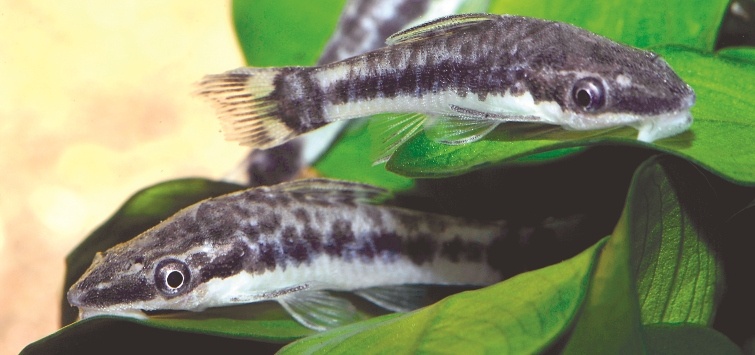
Algae on aquarium plants can be found to some degree in many fish tanks. But you can run your aquarium in such a way that will help keep it free of visible algae outbreaks, controlling light and nutrients to maximize their benefit to your plants and thereby helping them outcompete the algae. And by understanding the various types of algae you may encounter and knowing how to get rid of algae in the fish tank, you’ll have extra ammunition in the fight against algae, helping to keep your aquascape beautiful and healthy for both fish and plants.

.png?h=595&iar=0&w=2781&hash=5FD5E69473BCC22199FBFA2FB71B6033)
